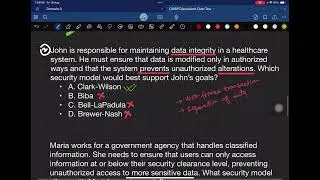CISSP Series Domain3 Episode 22 - Selecting Security Controls: A Comprehensive Guide
Selecting Security Controls: A Comprehensive Guide
Hello, friends, CISSPians!!! Welcome to another insightful journey into the world of cybersecurity. Today, we'll explore a critical aspect of securing systems – selecting security controls based on specific requirements. Buckle up as we delve into the nuances of this process.
Defining the System
Before we embark on the quest for security controls, it's imperative to define the system in question. A system could be anything – a small software, hardware, a blend of both, or even an entire organizational department. Once the system is clearly defined, the journey towards selecting appropriate security controls begins.
Three Dimensions of Security Control Selection
1. Regulatory and Compliance Considerations
The first and foremost dimension involves giving due consideration to the regulatory and compliance requirements of the system. Whether you're dealing with commercial or non-commercial work, understanding the governance of the system from a regulatory standpoint is crucial. For instance, companies processing debit and credit cards must comply with PCI DSS standards.
2. Threat Modeling
The second dimension takes us into the realm of threat modeling. It requires contemplating the potential threats that could undermine the system's functioning. This involves a systematic threat analysis, enabling the selection of security controls that align with identified threats.
3. Risk Assessment
The third dimension revolves around conducting a risk assessment tailored to the organization's context. Different industries may have unique approaches to risk assessment, leading to specific security control points. This involves prioritizing security activities based on identified risks.
Starting Point: Defining a Framework
When it comes to selecting controls for a specific system security requirement, the starting point is to define a framework. There are three broad categories of frameworks to choose from:
1. Control Frameworks
Control frameworks, such as NIST 800-53 and CIS controls, provide a baseline set of controls. They assess the state of technical capabilities, prioritize control implementation, and develop an initial roadmap.
2. Program Frameworks
Program frameworks assess the overall security program, measure maturity, and facilitate communication with business leaders. ISO and the Cybersecurity Framework are notable examples.
3. Risk Frameworks
Risk frameworks, like ISO 27,005 and FAIR, define key processes for assessing and managing risk. They identify, measure, and quantify risk, ultimately prioritizing security activities.
Key Characteristics of Frameworks
It's essential to understand a few key characteristics of frameworks:
Frameworks are not mandatory. Their adoption depends on the organization and the design of the system security.
They are not mutually exclusive. Overlapping controls exist between different frameworks.
Frameworks are not exhaustive. No single framework covers all aspects of security.
Conclusion
In conclusion, the process of selecting security controls is a multifaceted journey. It starts with defining the system, followed by incorporating regulatory, threat, and risk considerations into a suitable framework. Remember, frameworks are not one-size-fits-all; choose based on your organization's needs.
I hope you found this video valuable. In upcoming articles, we'll delve into technical terms such as cryptography, encryption algorithms, and more. Best of luck with your CISSP exams!
Stay tuned for more cybersecurity insights!
#cisspexam #cissp #cissptraining































